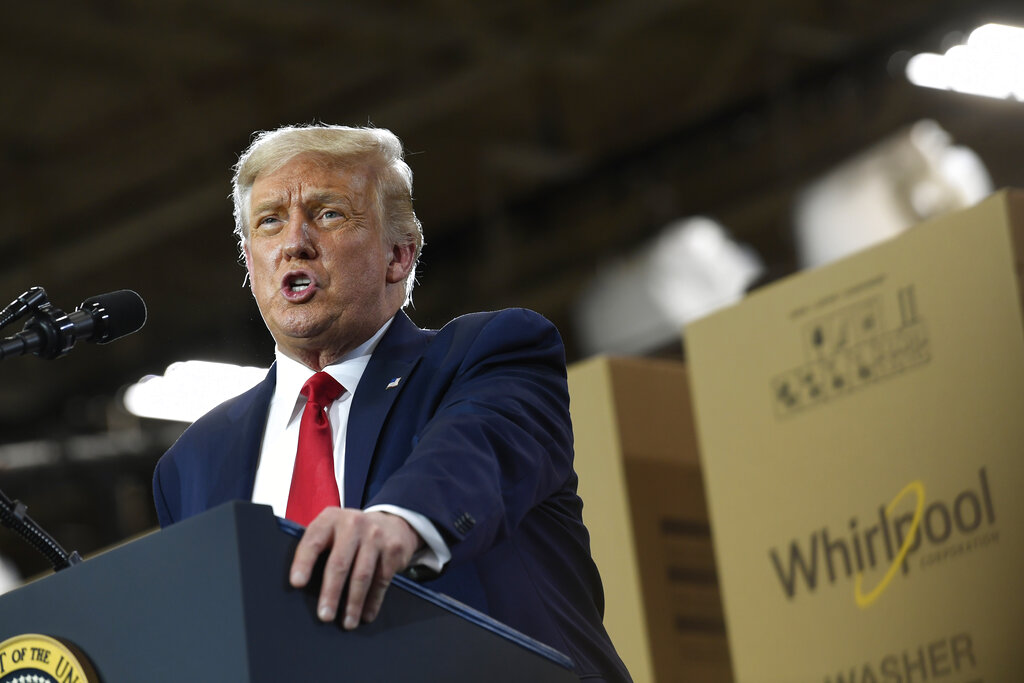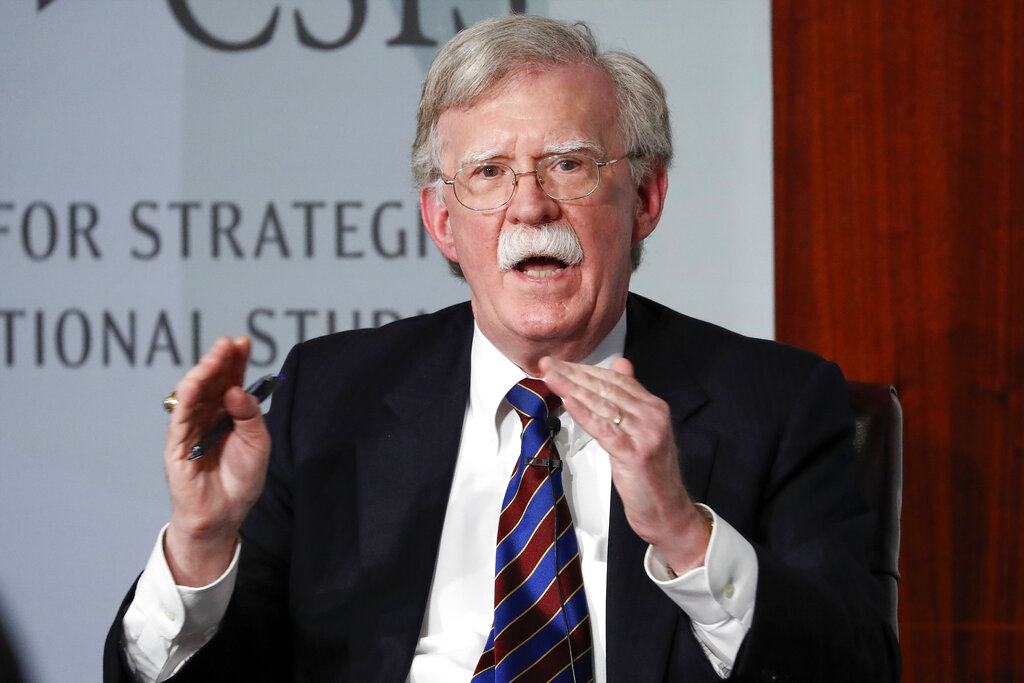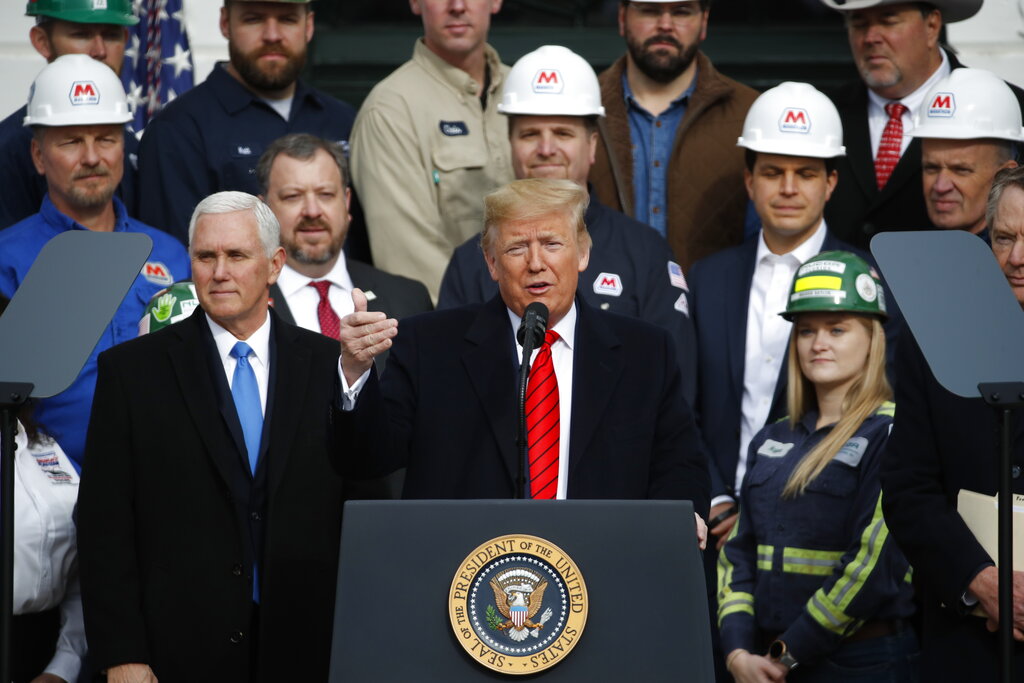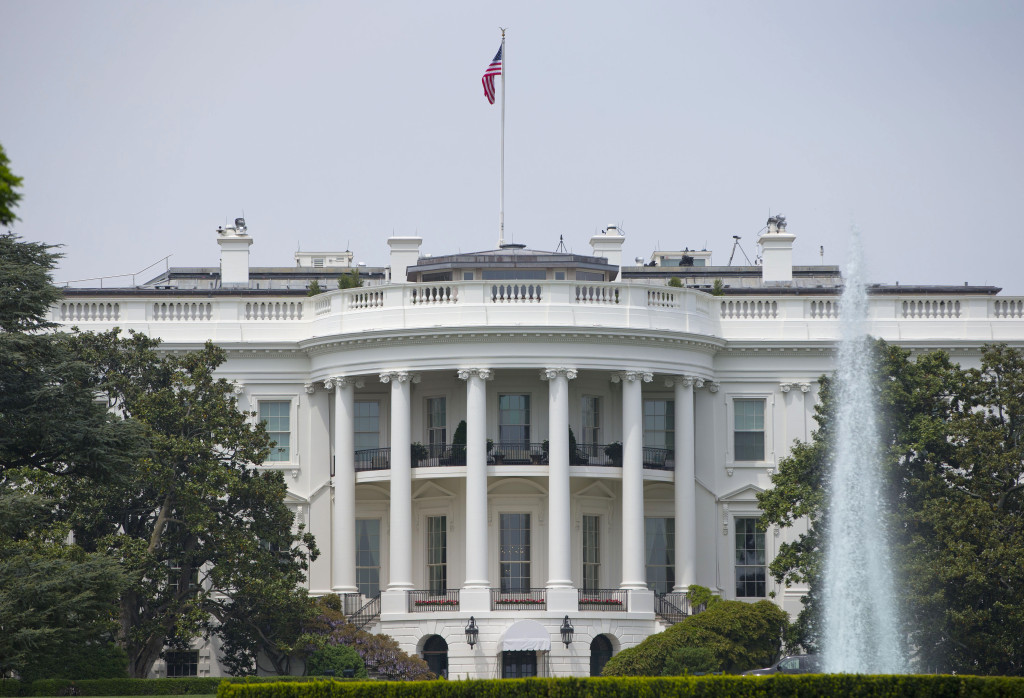Playing electoral defense, Donald Trump claims Joe Biden opposes God

Trump’s remarks stood out and they signaled how contentious the campaign may get over the coming months.
John Bolton says Donald Trump asked China to help him get reelected

The White House worked furiously to block the book, asking a federal court for an emergency temporary restraining order Wednesday against its release.
Donald Trump: New trade deal with Canada, Mexico to boost US growth

Renegotiating NAFTA was a priority for Donald Trump in the 2016 campaign.
North America trade pact deals rare setback to big pharma
![[Photo Credit: canva.com]](https://altoday.com/wp-content/uploads/2018/10/Canva-Cure-Drug-Cold-Dose-The-Disease-Pharmacy-1024x683.jpg)
A revamped North American trade deal nearing passage in Congress gives both the White House and Democrats a chance to claim victory and offers farmers and businesses clearer rules governing the vast flow of goods among the United States, Canada and Mexico. But the pact leaves at least one surprising loser: the pharmaceutical industry, a near-invincible lobbying powerhouse in Washington. To satisfy House Democrats, the Donald Trump administration removed a provision that would have given the makers of ultra-expensive biologic drugs 10 years of protection from less expensive knockoffs. Democrats opposed what they called a giveaway to the industry that could have locked in inflated prices by stifling competition. Top examples of the injected drugs made from living cells include medications to fight cancer and immune disorders such as rheumatoid arthritis. “This is one of the first times we’ve actually seen pharma lose,” said Rep. Earl Blumenauer, an Oregon Democrat who leads a subcommittee on trade. “They have a remarkable track record because they are a huge political force. They spend lots of money on lobbying, on advertising, on campaign contributions. But we held firm, and we won on all counts.” The removal of the provision also helped illustrate just how potent a political issue sky-high drug prices have become. It was a reminder, too, that President Donald Trump repeatedly pledged to work to lower drug prices. Last week, drug manufacturers absorbed another — though likely only temporary — defeat when House Democrats passed legislation, along party lines, that would authorize Medicare to use its influence in the marketplace to negotiate lower prices from drug companies. The bill is thought to have no chance of passage, though, in the Republican-led Senate. Yet the revamped U.S.-Mexico-Canada Agreement, Trump’s rewrite of the 25-year-old North American Free Trade Act, seems set to clear Congress without the biologics protection that the drug industry had sought. On Tuesday, the House Ways and Means Committee approved the legal text. The full House is expected to approve it Thursday, though the Senate isn’t likely to take it up until January. “It’s not a mystery,’’ said Rep. Jan Schakowsky, an Illinois Democrat who helped negotiate with the administration. “If you poll the American people, the cost of pharmaceuticals is a really big deal. It’s at the top of the list.’’ The trade agreement the administration reached last year with Mexico and Canada gave biologics 10 years of protection from cheaper near-copies known as biosimilars. Among the leading biologics are the anti-cancer drug Rituxan and Humira and Enbrel, which fight immune disorders. The industry — and the Trump administration — had argued that manufacturers of biologics require years of protection to profit from their drugs before biosimilars should be allowed to cut into sales. Otherwise, they contend, brand-name drug companies and biotech startups that rely on money from venture capital firms would have little incentive to invest in developing new medicines. “The announcement made today puts politics over patients,” the leading drug industry trade group, PhRMA, said in a statement last week. “Eliminating the biologics provision in the USMCA removes vital protections for innovators while doing nothing to help U.S. patients afford their medicines or access future treatments and cures.’’ The industry also rejected the notion that the biologics provision would keep drug prices high and hurt consumers. Existing U.S. law, they noted, already gives makers of biologics 12 years’ protection, more than the proposed 10 years in the USMCA. But the provision the Democrats succeeded in removing would have forced Mexico to expand biologics’ monopoly from five years and Canada from eight, potentially hurting U.S. consumers who seek lower drug prices in those countries. What’s more, Democrats argued, if Congress had expanded the biologics’ monopoly in the USMCA, it would have prevented lawmakers from ever scaling back that monopoly to, say, the seven years that the Obama administration had once proposed. “We would have been locked in,’’ Schakowsky said. For Big Pharma, the setback marked a sharp turnabout. Four years ago, the drug industry helped scuttle an Obama administration trade deal with 11 Pacific Rim countries, arguing that a provision establishing eight years of protection for biologics was not sufficient. Now the latest U.S. trade deal contains no biologics protections at all. Back in 2006, the industry scored a major victory when it helped push legislation through Congress that added prescription drug coverage for Medicare recipients but barred the government from negotiating lower prices. That restriction opened a “Pandora’s box” that paved the way for unsustainable price hikes, said Steve Brozak, an analyst at WBB Securities. Drug makers began raising prices of existing drugs several times a year, sometimes totaling more than 20% annually. They also started launching biologics with list prices topping six figures a year. In May, U.S. regulators approved a one-time gene therapy, Zolgensma, with an eye-popping price of $2.1 million per patient. A backlash has been growing, especially after news reports and congressional hearings exposed stories of patients rationing medicine and even dying because they couldn’t afford insulin or other drugs. Drugmakers have “been on defense more than we’ve ever seen,” said David Certner, legal counsel for AARP. Last year, Certner noted, Congress dealt the industry two losses: First, by increasing the discounts that drug makers must give to seniors with high drug costs who have landed in a Medicare coverage gap. Then, months later, lawmakers rejected industry efforts to reverse that change. And in January, the industry lost perhaps its biggest champion in Congress when Sen. Orrin Hatch, Republican-Utah, retired. Trump has long promised to address drug prices. On Wednesday, the administration moved ahead with a plan to allow Americans to safely and legally gain access to lower-priced medicines from abroad. So far, most of Trump’s drug-price initiatives have gone nowhere. His trade team negotiated biologics protections into the USMCA. Facing public anger, Democratic resistance and the fact that Canada and Mexico had no reason to support the protections for biologics, the administration yielded. When it reached a deal with House Democrats
Democrats, White House forge new North American trade deal

House Democrats and the White House announced a deal on a modified North American trade pact, handing President Donald Trump a major Capitol Hill win Tuesday on the same day that impeachment charges were announced against him. Both sides hailed the deal as a win for American workers. They said the revamped U.S.-Mexico-Canada Agreement was a significant improvement over the original North American Free Trade Agreement, with Democrats crowing about winning stronger provisions on enforcing the agreement while Republicans said it will help keep the economy humming along. “There is no question of course that this trade agreement is much better than NAFTA,” House Speaker Nancy Pelosi, Democrat-California, said in announcing the agreement, saying the pact is “infinitely better than what was initially proposed by the administration.” Trump said the revamped trade pact will “be great” for the United States. “It will be the best and most important trade deal ever made by the USA. Good for everybody – Farmers, Manufacturers, Energy, Unions – tremendous support. Importantly, we will finally end our Country’s worst Trade Deal, NAFTA!,” the president said in a tweet. The deal announcement came on the same morning that Democrats outlined impeachment charges against Trump. The trade pact is Trump’s top Capitol Hill priority along with funding for his long-sought border fence. In Mexico City, President Donald Trump’s son-in-law and senior adviser, Jared Kushner, U.S. Trade Representative Robert Lighthizer and Canadian Deputy Prime Minister Chrystia Freeland joined Mexican officials to sign the updated version of the United States-Mexico-Canada trade agreement, or USMCA, at a ceremony in Mexico City’s centuries-old National Palace. Mexican Foreign Minister Marcelo Ebrard congratulated the negotiators for reaching a second set of agreements to answer U.S. concerns about labor rights in Mexico, and regional content. “Mission accomplished!” Ebrard told the gathered officials. Lighthizer praised the joint work of the Trump administration, Democrats, business and labor leaders to reach an agreement, calling it “nothing short of a miracle that we have all come together.” “This is a win-win-win agreement which will provide stability for working people in all three countries for years to come,” Freeland said. “That is no small thing.” A U.S. House vote is likely before Congress adjourns for the year and the Senate is likely to vote in January or February. Pelosi was the key congressional force behind the deal, which updates the 25-year-old NAFTA accord that many Democrats — especially from manufacturing areas hit hard by trade-related job losses — have long lambasted. She and Ways and Means Committee Committee Chairman Richard Neal, Democrat-Massachusetts, forged a positive working relationship with Lighthizer, whom they credited with working in good faith. “Thanks to President Trump’s leadership, we have reached an historic agreement on the USMCA. After working with Republicans, Democrats, and many other stakeholders for the past two years we have created a deal that will benefit American workers, farmers, and ranchers for years to come,” Lighthizer said. “This will be the model for American trade deals going forward.” NAFTA eliminated most tariffs and other trade barriers involving the United States, Mexico and Canada. Critics, including Trump, labor unions and many Democratic lawmakers, branded the pact a job killer for the United States because it encouraged factories to move south of the border, capitalize on low-wage Mexican workers and ship products back to the U.S. duty free. Weeks of back-and-forth, closely monitored by Democratic labor allies such as the AFL-CIO, have brought the two sides together. Pelosi is a longtime free trade advocate and supported the original NAFTA in 1994. Trump has accused Pelosi of being incapable of passing the agreement because she is too wrapped up in impeachment. The original NAFTA badly divided Democrats but the new pact is more protectionist and labor-friendly, and Pelosi is confident it won’t divide the party, though some liberal activists took to social media to carp at the agreement. “There is no denying that the trade rules in America will now be fairer because of our hard work and perseverance. Working people have created a new standard for future trade negotiations,”said AFL-CIO President Richard Trumka. “President Trump may have opened this deal. But working people closed it.” Business groups like the U.S. Chamber of Commerce also chimed in to support the long-delayed agreement. “We are optimistic this development will open the door to final approval of USMCA on a bipartisan basis by the end of the year, which will especially benefit American farmers, manufacturers, and small businesses,” Thomas Donohue, CEO of the U.S. Chamber of Commerce, said in a statement. “This agreement has been the result of painstaking bipartisan negotiations over the past year, and would not have been possible if not for the willingness of President Trump to work patiently with Democrats to get something done that he knew was in the best interests of American workers, farmers and manufacturers,” said Sen. Rob Portman, Republican-Ohio, a former U.S. trade representative. Republicans leaders and lawmakers have agitated for months for the accord but Pelosi has painstakingly worked to bring labor on board. Democrats see the pact as significantly better than NAFTA and Trumka’s endorsement is likely to add to a strong vote by Democrats that have proven skeptical of trade agreements. “I think the vote’s going to be pretty good,” said No. 2 House Democrat Steny Hoyer, D-Md., a veteran party whip. “There’s a general agreement — not total agreement, it’s not unanimity — that USMCA is better. It’s an improvement. And to the extent that Trumka and labor comes out and says that this is an improvement, I think that that will be unifying.” The pact contains provisions designed to nudge manufacturing back to the United States. For example, it requires that 40 percent to 45 percent of cars eventually be made in countries that pay autoworkers at least $16 an hour — that is, in the United States and Canada and not in Mexico. The trade pact picked up some momentum after Mexico in April passed a labor-law overhaul required by USMCA. The reforms are meant
U.S.-China trade talks center on rivalry over technology

A high-powered U.S. delegation arrived in Beijing on Thursday for talks with Chinese officials on defusing tensions that are propelling the world’s two largest economies toward a trade war. Treasury Secretary Steven Mnuchin is leading the group, which includes Commerce Secretary Wilbur Ross and U.S. Trade Representative Robert Lighthizer. Liu He, President Xi Jinping’s top economic adviser, was heading the Chinese side in the talks, which analysts say appear unlikely to yield a breakthrough given the two sides’ intensifying rivalry in strategic technologies. President Donald Trump said he expected relations with Beijing to stay on an even keel. “Our great financial team is in China trying to negotiate a level playing field on trade!” he said on Twitter late Wednesday. “I look forward to being with President Xi in the not too distant future. We will always have a good (great) relationship!” Trump is seeking to cut the chronic U.S. trade deficit by $100 billion and gain concessions over policies that foreign companies say force them to share technology with Chinese partners in order to gain market access. His administration has threatened to impose new tariffs on roughly $150 billion in Chinese goods — prompting China to announce its own tariffs on U.S. goods. The dispute has deepened as China stepped up efforts to overtake western industry leaders in advanced technologies, especially for semiconductors, the silicon brains required to run smartphones, connected cars, cloud computing and artificial intelligence. Under Xi, a program known as “Made in China 2025” aims to make China a tech superpower by advancing development of industries that in addition to semiconductors includes artificial intelligence, pharmaceuticals and electric vehicles. The plan mostly involves subsidizing Chinese firms. But it also does require foreign companies to provide key details about their technologies to Chinese partners. Beijing looks unlikely to cede any ground on that strategic blueprint. “The Made in China 2025 industrial policy concerns China’s long-term development plan, so the overall direction won’t change at all,” said Yu Miaojie, professor at Peking University’s National School of Development. Yu says China would rather cut the trade deficit by importing high-tech products from the U.S. that are currently tightly restricted. Striking an adamant tone, the state-run Global Times newspaper said Thursday in a commentary that it’s “our sovereign right to develop high-tech industry and it is connected to the quality of rejuvenation of the Chinese nation. It will not be abandoned due to external pressure.” Both sides have shown a diversity of opinions, with China recently moving to loosen a restriction on foreign ownership of automakers to minority stakes. But the rival views in Washington, reflected in the makeup of the U.S. team, could undermine the U.S. negotiating stance, the consulting firm Eurasia Group said in a research note. “The U.S. delegation headed to Beijing is too large and unwieldy to accomplish much; it is a reflection of inter-agency rivalry on the U.S. side and this will produce more posturing than actual negotiations with the Chinese,” the firm said. “The trip will produce few results and increases the risk that tariffs are adopted in the near future,” it added. Washington’s recent decision to ban Chinese telecom gear maker ZTE from importing U.S. components in a sanctions-related case drove home to Beijing its costly vulnerability to foreign sources for advanced microchips. The “Made in China 2025” plan calls for domestic producers to supply 70 percent of the country’s chip demand. The Trump administration’s efforts may actually spur China to ramp up efforts to develop its domestic industry as it strives to fulfill Xi’s vision, said Jian-Hong Lin, an analyst at research firm TrendForce. China now consumes nearly 60 percent of the world’s semiconductors but supplies only about 16 percent, according to PWC. The country spends more than $200 billion a year on foreign-made semiconductors, which in 2015 surpassed crude oil as the country’s biggest import. Experts say Chinese chipmakers are five years behind their U.S. and Asian rivals and that increasingly high technological hurdles and a meager talent pool are hindering the effort to catch up with dominant U.S., Japanese, South Korean and Taiwanese manufacturers. As Chinese researchers and chipmakers strive to catch up, the technology is evolving, with new materials transforming the future landscape of the electronics industry. The latest advanced chips are highly complex to make because of their increasingly tiny “nodes,” measured in nanometers, that make them faster and more power-efficient. Beijing has been backing up its towering ambitions in the semiconductor sector with money and tax breaks. The government set up the National Integrated Circuit Industry Investment Fund in 2014, seeded with 140 billion yuan ($22 billion) in capital to invest in chip companies. A second round of fundraising for as much as 200 billion yuan is underway, Chinese media report. The state-controlled Tsinghua Unigroup project, associated with Tsinghua University — China’s equivalent of MIT — has emerged as a national champion. It’s building two massive memory chip factories, including a $30 billion facility in Nanjing that will churn out 100,000 wafers a month and is expected to exert a “siphon effect,” drawing microchip industry suppliers and experts to the area. It’s unclear how successful those efforts will be as foreign regulators push back against Beijing’s strategy of acquiring overseas chipmaking-related firms. Washington has scuppered multiple China-linked bids for semiconductor-related firms following a call from a White House advisory panel to do more to protect the U.S. industry because of China’s industrial policies. Market leaders like Samsung, Intel and Taiwan Semiconductor Manufacturing are investing aggressively as they fight for market share. “Even though they’ve (the Chinese) committed a lot of money to the investment fund, the reality has sunk in that it’s harder than just throwing money at the problem. The Samsungs of the world, the TSMCs have a large head start,” said Alexander Wolf, an economist at Aberdeen Standard Investments. “Certain products, you can’t really reverse engineer.” Companies like Huawei and ZTE are avidly pursuing advanced semiconductor technology, but experts say overall Chinese research and development


